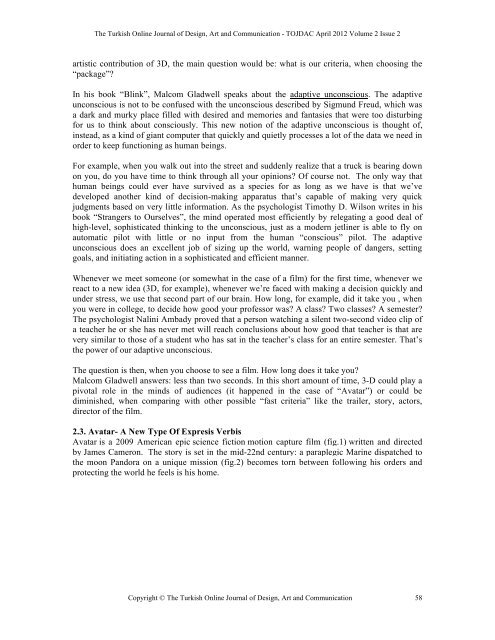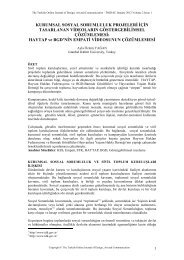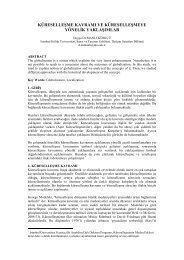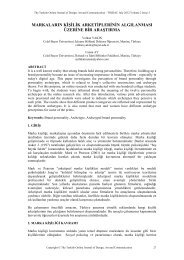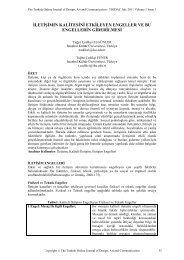aprıl 2012 - tojdac.org
aprıl 2012 - tojdac.org
aprıl 2012 - tojdac.org
You also want an ePaper? Increase the reach of your titles
YUMPU automatically turns print PDFs into web optimized ePapers that Google loves.
The Turkish Online Journal of Design, Art and Communication - TOJDAC April <strong>2012</strong> Volume 2 Issue 2<br />
artistic contribution of 3D, the main question would be: what is our criteria, when choosing the<br />
“package”<br />
In his book “Blink”, Malcom Gladwell speaks about the adaptive unconscious. The adaptive<br />
unconscious is not to be confused with the unconscious described by Sigmund Freud, which was<br />
a dark and murky place filled with desired and memories and fantasies that were too disturbing<br />
for us to think about consciously. This new notion of the adaptive unconscious is thought of,<br />
instead, as a kind of giant computer that quickly and quietly processes a lot of the data we need in<br />
order to keep functioning as human beings.<br />
For example, when you walk out into the street and suddenly realize that a truck is bearing down<br />
on you, do you have time to think through all your opinions Of course not. The only way that<br />
human beings could ever have survived as a species for as long as we have is that we’ve<br />
developed another kind of decision-making apparatus that’s capable of making very quick<br />
judgments based on very little information. As the psychologist Timothy D. Wilson writes in his<br />
book “Strangers to Ourselves”, the mind operated most efficiently by relegating a good deal of<br />
high-level, sophisticated thinking to the unconscious, just as a modern jetliner is able to fly on<br />
automatic pilot with little or no input from the human “conscious” pilot. The adaptive<br />
unconscious does an excellent job of sizing up the world, warning people of dangers, setting<br />
goals, and initiating action in a sophisticated and efficient manner.<br />
Whenever we meet someone (or somewhat in the case of a film) for the first time, whenever we<br />
react to a new idea (3D, for example), whenever we’re faced with making a decision quickly and<br />
under stress, we use that second part of our brain. How long, for example, did it take you , when<br />
you were in college, to decide how good your professor was A class Two classes A semester<br />
The psychologist Nalini Ambady proved that a person watching a silent two-second video clip of<br />
a teacher he or she has never met will reach conclusions about how good that teacher is that are<br />
very similar to those of a student who has sat in the teacher’s class for an entire semester. That’s<br />
the power of our adaptive unconscious.<br />
The question is then, when you choose to see a film. How long does it take you<br />
Malcom Gladwell answers: less than two seconds. In this short amount of time, 3-D could play a<br />
pivotal role in the minds of audiences (it happened in the case of “Avatar”) or could be<br />
diminished, when comparing with other possible “fast criteria” like the trailer, story, actors,<br />
director of the film.<br />
2.3. Avatar- A New Type Of Expresis Verbis<br />
Avatar is a 2009 American epic science fiction motion capture film (fig.1) written and directed<br />
by James Cameron. The story is set in the mid-22nd century: a paraplegic Marine dispatched to<br />
the moon Pandora on a unique mission (fig.2) becomes torn between following his orders and<br />
protecting the world he feels is his home.<br />
Copyright © The Turkish Online Journal of Design, Art and Communication 58


